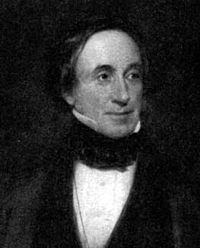William Hopkins facts for kids
Quick facts for kids
William Hopkins
|
|
|---|---|

William Hopkins (1793–1866)
|
|
| Born | 2 February 1793 Kingston-on-Soar, Nottinghamshire, England, Kingdom of Great Britain
|
| Died | 13 October 1866 (aged 73) |
| Nationality | English |
| Alma mater | St Peter's College, Cambridge |
| Known for | Finding that melting point increases with pressure |
| Awards | Wollaston Medal (1850) |
| Scientific career | |
| Fields | Mathematician and geologist |
| Institutions | University of Cambridge |
| Academic advisors | Adam Sedgwick |
| Notable students | Edward John Routh Francis Galton George Gabriel Stokes Arthur Cayley Lord Kelvin Peter Guthrie Tait James Clerk Maxwell Isaac Todhunter Philip Kelland |
William Hopkins (2 February 1793 – 13 October 1866) was an English mathematician and geologist. He was also a Fellow of the Royal Society, which is a special honor for top scientists.
He was well-known as a private tutor for students at the University of Cambridge. He helped many young mathematicians become "Senior Wranglers," which was the highest math honor at the university. Because of this, people called him the "senior-wrangler maker."
Hopkins also studied the Earth's inside. He believed the Earth had a solid core, not a liquid one. He used his ideas to explain many geological events. Even though his math was later found to be a bit off, his main ideas about the Earth's structure turned out to be right!
Contents
Early Life and Education
William Hopkins was born in Kingston-on-Soar, England. He was the only son of a farmer. When he was young, he learned about farming. Later, his father rented him a small farm.
However, farming was not for William. After his first wife passed away around 1821, he decided to try something new. He went to St Peter's College at the University of Cambridge. He earned his first degree in 1827 and a master's degree in 1830.
The "Wrangler Maker"
Before he finished college, William Hopkins married Caroline Frances Boys. Because he was married, he could not become a "fellow" at the university. Instead, he became a private tutor. He coached young math students who wanted to become "Senior Wranglers." This was a very important and difficult math award at Cambridge.
Hopkins was incredibly good at teaching. He helped almost 200 students become "wranglers" by 1849. Seventeen of his students even became "Senior Wranglers." Some of his most famous students included Lord Kelvin, James Clerk Maxwell, and Arthur Cayley.
One of his students, Francis Galton, really liked his teaching style. Galton said that Hopkins made math fun and interesting. He told funny stories and helped students understand the deeper ideas behind math.
Hopkins also taught Edward Routh, who later became a "Senior Wrangler" himself. Routh then became a famous "wrangler maker" too! In 1833, Hopkins wrote a book called Elements of Trigonometry.
There's a cool story about how Hopkins helped save the work of another mathematician, George Green. In 1845, Lord Kelvin, who was a young man and a former student of Hopkins, got copies of Green's important math book from Hopkins. Lord Kelvin then helped make Green's work famous.
Exploring Earth's Secrets: Geology
Around 1833, William Hopkins met Adam Sedgwick, another famous geologist. They went on several trips together, and Hopkins became very interested in geology.
From then on, Hopkins focused on what he called physical geology. This meant using math to study how forces from inside the Earth could change its surface. He looked at how mountains formed, how cracks (fissures) appeared, and how faults (breaks in the Earth's crust) happened. He studied areas like the Lake District in England using his ideas.
Hopkins believed the Earth was mostly solid, but with some spaces inside. He thought hot gases or liquids in these spaces could push up the Earth's surface. This idea was different from what Charles Lyell believed. Lyell thought the Earth's inside was mostly liquid, with only a thin solid crust.
Hopkins used his math skills to study the Earth's rotation (how it spins). He looked at things like how the Earth wobbles slightly (precession and nutation). He said his studies showed that the Earth must have a solid inside, not a liquid one. He also used his model to explain earthquakes and volcanoes.
To learn more, Hopkins studied how huge pressures affect the melting point of different materials. He got help from other scientists like Lord Kelvin and James Prescott Joule. They did experiments that Hopkins believed supported his ideas. He also thought that the Earth's cooling over time had not really changed the climate much.
In the end, even though Hopkins's ideas about the Earth's solid inside were correct, Lord Kelvin later showed that some of Hopkins's math and physics reasoning was not perfect.
Glaciers and Ice
Hopkins also wrote about how glaciers move and how they carry large rocks (glacial erratics). However, another scientist named James David Forbes felt that this was his area of study. Forbes thought Hopkins didn't have enough experience watching glaciers in person.
Personal Life
William Hopkins enjoyed many things outside of science, like music, poetry, and painting landscapes.
Later in his life, he needed special care due to a long illness. He passed away in 1866.
He had one son and three daughters with his second wife. One of his daughters was Ellice Hopkins, who became known for her work in social causes.
William Hopkins also played first-class cricket from 1825 to 1828. He played for the Cambridge University Cricket Club.
Honors and Awards
- Fellow of the Royal Society (1 June 1837)
- Geological Society of London:
- Wollaston Medal (1850)
- President (1851)
- President of the British Association (1853)

